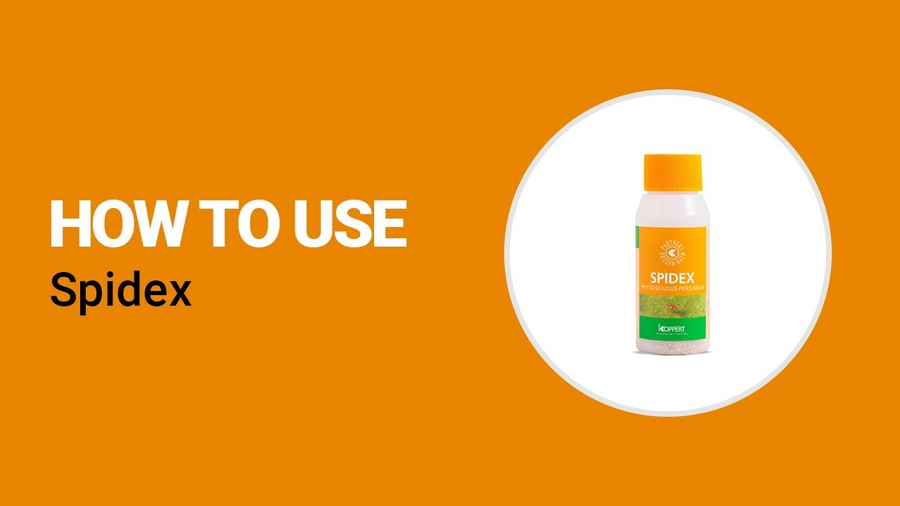The predatory mite Phytoseiulus persimilis is by far the most important natural enemy of Two-spotted spider mite (Tetranychus urticae) and has been used in many crops worldwide, mainly in greenhouses, but also in outdoor crops such as strawberries. This predatory mite was the first biological control agent used commercially in greenhouses and Koppert’s very first product in 1967. It is a specialist predator of spider mites and can control spider mite infestations very quickly but doesn’t feed on any other prey. Under dry, warm conditions Phytoseiulus persimilis has difficulties keeping spider mites under control.
Phytoseiulus persimilis for pest control
Phytoseiulus persimilis is used for the control of the following pests:
Phytoseiulus persimilis mites actively seek out and prey on the Two-spotted spider mite (Tetranychus urticae). The predatory mite cannot feed on other prey.
Feeding behaviour of Phytoseiulus persimilis
Phytoseiulus persimilis feeds on all stages of spider mites, but has a preference for eggs. The predatory mites pierce the prey with their mouthparts and suck out the contents. The adult Phytoseiulus persimilis also attacks adult spider mites but the earlier development stages only feed on smaller prey stages. The larvae do not eat. They develop quickly to protonymph and then start to feed on spider mites. The quantity of prey consumed depends on the predator and prey populations, the sex and age of the predator, and the temperature and relative humidity. In general, the consumption of prey increases if the temperature increases. Prey consumption decreases at temperatures above 30°C. Above 35°C, Phytoseiulus persimilis stops feeding altogether.
The optimal temperature for controlling spider mite is between 15 and 25°C. At about 20°C with good prey supply, an adult female consumes up to five adult spider mites or 20 young larvae or eggs per day. Because the development rate of the predatory mite is roughly twice that of the spider mite, the number of predatory mites increases rapidly, and they quickly reduce the spider mite population by predation. Phytoseiulus persimilis is highly specific and is only effective against spider mites that produce a large amount of webbing. It can move within the web with ease. This has the advantage that an outbreak is quickly and effectively dealt with, but the disadvantage is that it disappears rapidly in the absence of suitable prey. When prey is in short supply, mainly adult females will leave the prey patch in search of other spider mite colonies. Their population will decline dramatically in the absence of spider mites and predatory mites will become cannibalistic. If new hot spots of spider mites appear, it may be necessary to reintroduce predatory mites.
Life cycle of Phytoseiulus persimilis
The adult mites are orange-red with eight long legs and highly active, particularly at higher temperatures. Females are approximately 0.6 mm in length, and although males are slightly smaller, flatter and more elongated, they are difficult to distinguish from the females. When moving, the mites stir their first pair of legs up and down in the air as these legs bear sensory organs to register volatiles emitted by damaged plants. Phytoseiid mites have no eyes and therefore rely on volatiles released by damaged plants and their tactile sense to find their prey. The developmental stages of Phytoseiulus persimilis are the same as those of spider mites: egg, larva, protonymph, deutonymph and adult, except for the resting period in the larval and nymphal stages. On plants, the oval eggs are usually deposited close to, or in a spider mite colony. They are approximately twice the size of spider mite eggs and a transparent light pink when freshly laid, turning slightly darker later on. The larvae have three pairs of legs. They do not feed and remain inactive unless disturbed. Once the larva has moulted to the protonymph (with four pairs of legs) stage, it begins feeding immediately. During the protonymphal, deutonymphal and adult stages the mites feed almost continuously. Protonymphs and deutonymphs are similar to the adults in appearance, but smaller in size.
Best conditions for use of Phytoseiulus persimilis
Phytoseiulus persimilis is most effective at temperatures between 13 and 27°C (55 and 81°F) and not effective above 30°C/86°F. Phytoseiulus persimilis is sensitive to relative humidity below 70%.
Phytoseiulus persimilis in bottles
The predatory mite Phytoseiulus persimilis is available in a bottle (Spidex, Spidex Vital, Spidex Boost).
- Turn and shake the bottle gently before use
- Push the centre of the cap to open the dosage hole
- Sprinkle material on leaves or pour into Diboxes
- Make sure the material remains on the introduction site for at least a few hours after introduction
- Can also be applied with (Mini)-Air(o)bug
The dosage of Spidex, Spidex Vital, Spidex Boost depends on climate, crop and spider mite density and should always be adjusted to the particular situation. Start introduction as soon as the first pest mites are detected in the crop. Introduction rates typically range from 2-50 per m2/release. Releases should be repeated once or twice at weekly intervals. Consult a Koppert advisor or a recognized distributor of Koppert products for advice on the best strategy for your situation.
Phytoseiulus persimilis in sachets
The predatory mite Phytoseiulus persimilis is also available in breeding sachets (Spidex Vital Plus). In this case the predatory mites multiply in the sachet and disperse into the crop over a period of several weeks.
- Hang sachets in sheltered locations in the crop, avoid hanging into direct sunlight
- Sachets already have an exit hole
- Hold sachets by the cardboard strip at the top, to avoid damaging the predatory mites
The dosage of Spidex Vital Plus depends on climate, crop and pest density and should always be adjusted to the particular situation. Release should be repeated biweekly if the pest is not controlled. Consult a Koppert advisor or a recognized distributor of Koppert products for advice on the best strategy for your situation.


